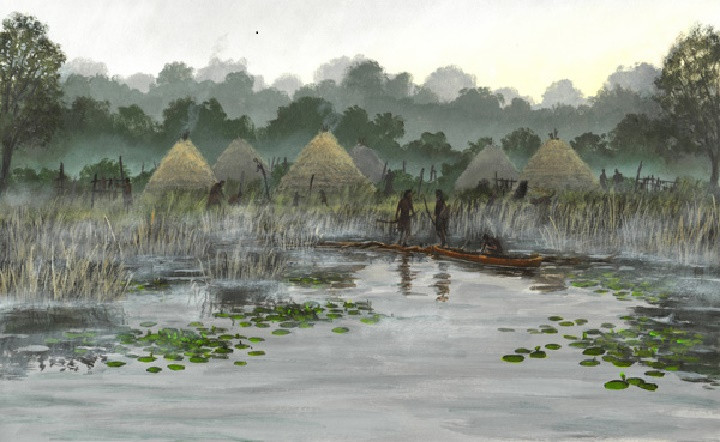Why do humans still survive the disaster thousands of years ago?
The first people to settle in England at the end of the ice age encountered sudden and unstable climate change. But they showed great resilience to this harsh change.
Researchers have conducted investigations on how mystical prehistoric people survived the period of extreme environmental change 11,000 years ago. These "cave" people once lived in the Mesolithic area of Star Carr in the north of England. Research results show that it seems that environmental fluctuations do not affect them.
"People still argue that unusual weather events can have a serious impact on the Mesolithic population in North England. But our research is again," said scientist Simon Blockley of Royal Holloway University in London . points out, at least the first communities in Star Carr can cope with extreme and persistent climate change events. "
In terms of archeology, Star Carr was first discovered in the 1940s. It is home to the relics of Britain's oldest house and the oldest carpentry found in Europe. Although houses and carpentry are popular, not all artifacts that exist during this hunting-gathering period are familiar to their ancestors - the British today.
Scientist Blockley and his colleagues discovered wooden structures, animal bones and ancient mud flakes in Star Carr. In addition, they also find sophisticated red deer antlers - suspicious of healers in mysterious rituals or hunters.
Ian Candy - one of the researchers said on CNN: "These deer horn hats are the most appealing to us. No one is sure what purpose they are used for, but their studies and The ethnological similarity gives a possibility: they are part of the mage's attire '.

Sketch of the old Star Carr area.(Photo: Dominic Andrews).
The deer horn hats, along with the remains, were excavated from the old lake basin in Vale, North Yorkshire starting from the era when the first group of people encountered climate change. Specifically, 9,300 and 11,100 years ago, two terribly cold climates took place. In about a decade, the temperature dropped by 10 degrees Celsius extremely quickly.

Deer horn hats.(Photo: University of York).
Researchers believe that this sudden climate change has a profound effect on the lives of people in Star Carr and the first wave of fluctuations has limited their activities. But they went through both harsh periods and barely changed their habits in the second cold winter."Certainly they have a high tolerance for climate instability. It is perseverance and the ability to maintain a stable society despite environmental stresses, " Candy said.
These possibilities come from the fact that prehistoric people make the best use of their skills and knowledge. It is about using stone tools and natural resources; hunting deer and fish; picking fruits and vegetables; make warm clothes and build rudimentary houses that can help them survive the sudden drop in temperature.

How do people survive climate change?(Photo: Sciencelert).
This is an inspirational story about the ability of people to adapt to climate change events. And it may change our thinking about how the ancestors fought against climate change. At some point, our modern people can do the same.
However, researchers also believe that we should not experience the past experiences to apply to the current situation. Because these groups are the first people to appear in the ice age. They are accustomed to living in the harshest climates and settling down on lands after the ice melts. In some ways, we are not like them, and it is this that makes a difference in an increasingly hot world of us.
The Candy scientist said in the newspaper: "The tradition of the people of Star Carr is to withstand the incredible climate changes at the end of the last period. Climate instability is part of In contrast, our society has existed for centuries, even if the millennium has a stable climate, we have no experience of sudden change on a large scale. "
This study was published in Nature Ecology & Evolution.
- How to survive the nuclear disaster
- Scary forecast: Humans are wiped out on Earth in the next 1000 years
- Video: Processing process to help the Egyptian school mummy survive for thousands of years
- It takes 100,000 years to recover the climate disaster
- Evidence of comets hitting the Earth, sweeping away life 13,000 years ago
- The ability to survive if humans returned 2.5 million years ago
- Uncover the secret to help animals survive the Chernobyl disaster
- Ants summon their fellow humans to survive in the bunker
- All kinds of animals survive when the price is cold
- Can a flu virus survive in a cold country?
- Disaster disaster
- 10 creatures can survive the nuclear war
 Discovered an ancient centipede fossil 99 million years old
Discovered an ancient centipede fossil 99 million years old Discovered bat-like dinosaurs in China
Discovered bat-like dinosaurs in China Discovered a 200-year-old bronze cannon of the coast
Discovered a 200-year-old bronze cannon of the coast Discover 305 million-year-old spider fossils
Discover 305 million-year-old spider fossils